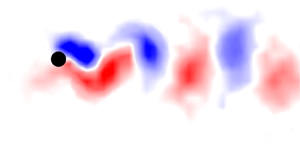Crossref Citations
This article has been cited by the following publications. This list is generated based on data provided by
Crossref.
Lorite-Díez, Manuel
Ern, Patricia
Cazin, Sébastien
Mougel, Jérôme
and
Bourguet, Rémi
2022.
An experimental study of flow–structure interaction regimes of a freely falling flexible cylinder.
Journal of Fluid Mechanics,
Vol. 946,
Issue. ,
Patel, Umang N.
Rothstein, Jonathan P.
and
Modarres-Sadeghi, Yahya
2022.
Vortex-induced vibrations of a cylinder in inelastic shear-thinning and shear-thickening fluids.
Journal of Fluid Mechanics,
Vol. 934,
Issue. ,
Luo, Fuqing
Gao, Chuanqiang
and
Zhang, Weiwei
2022.
The key to suppress vortex-induced vibration: Stability of the structural mode.
Journal of Fluids and Structures,
Vol. 113,
Issue. ,
p.
103692.
Lyu, Zhen
Kou, Jiaqing
and
Zhang, Weiwei
2022.
An experimental modal testing method for subcritical flow around a cylinder.
Physics of Fluids,
Vol. 34,
Issue. 8,
Yuan, Hao
Kou, Jiaqing
Gao, Chuanqiang
and
Zhang, Weiwei
2023.
Resolvent and dynamic mode analysis of flow past a square cylinder at subcritical Reynolds numbers.
Physics of Fluids,
Vol. 35,
Issue. 7,
Boersma, Pieter R.
Rothstein, Jonathan P.
and
Modarres-Sadeghi, Yahya
2023.
Experimental investigation of vortex-induced vibrations of a flexibly mounted cylinder in a shear-thinning fluid.
Physical Review Fluids,
Vol. 8,
Issue. 4,
Yao, Weiguang
Jia, Xiaoyu
Zhang, Hui
and
Gui, Mingyue
2023.
Suppression of vortex-induced vibration of an elastically mounted sphere by electromagnetic force.
Physics of Fluids,
Vol. 35,
Issue. 9,
Lyu, Zhen
and
Zhang, Wei-wei
2023.
Experimental evidence for the mechanism of subcritical vortex-induced vibration.
Journal of Hydrodynamics,
Vol. 35,
Issue. 1,
p.
17.
Hamid, Faheem
and
Sasmal, C.
2023.
Significant influence of fluid viscoelasticity on flow dynamics past an oscillating cylinder.
Journal of Fluid Mechanics,
Vol. 975,
Issue. ,
Bourguet, Rémi
2023.
Forced rotation enhances cylinder flow-induced vibrations at subcritical Reynolds number.
Journal of Fluid Mechanics,
Vol. 955,
Issue. ,
Bourguet, Rémi
2023.
Path curvature enhances the flow-induced vibrations of a cylinder without structural restoring force.
Journal of Fluid Mechanics,
Vol. 977,
Issue. ,
Chen, Chuan
Zhou, Jing-wei
Li, Fengming
and
Gong, Dehuang
2023.
Nonlinear vortex-induced vibration of wind turbine towers: Theory and experimental validation.
Mechanical Systems and Signal Processing,
Vol. 204,
Issue. ,
p.
110772.
Sun, Wan
Wang, Yiheng
Liu, Yang
Su, Bo
Guo, Tong
Cheng, Guanggui
Zhang, Zhongqiang
Ding, Jianning
and
Seok, Jongwon
2024.
Navigating the future of flow-induced vibration-based piezoelectric energy harvesting.
Renewable and Sustainable Energy Reviews,
Vol. 201,
Issue. ,
p.
114624.
Luo, Fuqing
Gao, Chuanqiang
Lyu, Zhen
and
Zhang, Weiwei
2024.
Elimination of lock-in phenomenon in vortex-induced vibration by passive modal control.
Journal of Fluid Mechanics,
Vol. 984,
Issue. ,
Carleton, Adrian
and
Modarres-Sadeghi, Yahya
2024.
Angular vortex-induced vibrations of a cylinder.
Journal of Fluids and Structures,
Vol. 126,
Issue. ,
p.
104087.
Zhao, Yawei
Chen, Weilin
Ji, Chunning
and
Zhang, Zhimeng
2024.
Flow-induced vibrations of an equilateral triangular prism at subcritical Reynolds number.
Physics of Fluids,
Vol. 36,
Issue. 11,
Boersma, Pieter R.
Rothstein, Jonathan P.
and
Modarres-Sadeghi, Yahya
2024.
Suppression of vortex-induced vibrations of a cylinder in inertial-elastic flow.
Journal of Non-Newtonian Fluid Mechanics,
Vol. 324,
Issue. ,
p.
105170.
Patel, Umang N.
Rothstein, Jonathan P.
and
Modarres-Sadeghi, Yahya
2024.
Viscoelasticity in the flow suppresses one- and two-degree-of-freedom vortex-induced vibrations of a cylinder.
Physical Review Fluids,
Vol. 9,
Issue. 11,
Liu, Xiaowei
Hu, Chunji
Liu, Deping
Tian, Haigang
and
Wang, Junlei
2024.
Vibration characteristic of free-to-rotate elliptical cylinder at low Reynolds number.
Ocean Engineering,
Vol. 293,
Issue. ,
p.
116576.
Heydari, Shayan
and
Jaiman, Rajeev K.
2025.
Flow-induced vibration of a flexible cantilever in tandem configuration.
Physical Review Fluids,
Vol. 10,
Issue. 2,

 $Re=47$. This might give the impression that a vortex-induced vibration (VIV), which occurs when the frequency of vortex shedding in the wake of a flexibly mounted cylinder synchronizes with the natural frequency of the structure, could be observed only at Reynolds numbers larger than
$Re=47$. This might give the impression that a vortex-induced vibration (VIV), which occurs when the frequency of vortex shedding in the wake of a flexibly mounted cylinder synchronizes with the natural frequency of the structure, could be observed only at Reynolds numbers larger than  $Re=47$. Recent numerical simulations and theoretical work, however, have shown that it is possible to observe VIV at subcritical Reynolds numbers, i.e. Reynolds numbers smaller than
$Re=47$. Recent numerical simulations and theoretical work, however, have shown that it is possible to observe VIV at subcritical Reynolds numbers, i.e. Reynolds numbers smaller than  $Re=47$. In these studies, a VIV has been observed numerically at Reynolds numbers as low as
$Re=47$. In these studies, a VIV has been observed numerically at Reynolds numbers as low as  $Re=22$. In the present work, the first experimental evidence of VIV at subcritical Reynolds number is presented. We have designed and built an experimental set-up that makes it possible to conduct VIV experiments at subcritical Reynolds numbers, and at a constant Reynolds number over the entire lock-in range (i.e. the range for which oscillations are observed). Using this experimental set-up, we have confirmed experimentally that VIV can indeed be observed at subcritical Reynolds numbers, by observing VIV at Reynolds numbers as low as
$Re=22$. In the present work, the first experimental evidence of VIV at subcritical Reynolds number is presented. We have designed and built an experimental set-up that makes it possible to conduct VIV experiments at subcritical Reynolds numbers, and at a constant Reynolds number over the entire lock-in range (i.e. the range for which oscillations are observed). Using this experimental set-up, we have confirmed experimentally that VIV can indeed be observed at subcritical Reynolds numbers, by observing VIV at Reynolds numbers as low as  $Re=19$. We have observed subcritical VIV both when the Reynolds number stays constant over the entire lock-in range, and when the Reynolds number increases with increasing reduced velocity, while staying within the subcritical range.
$Re=19$. We have observed subcritical VIV both when the Reynolds number stays constant over the entire lock-in range, and when the Reynolds number increases with increasing reduced velocity, while staying within the subcritical range.


